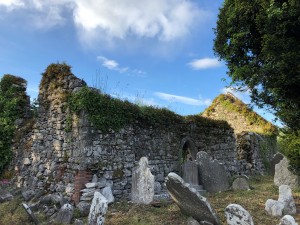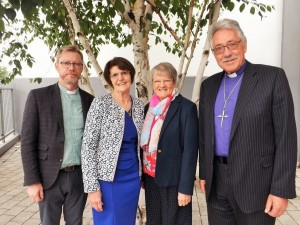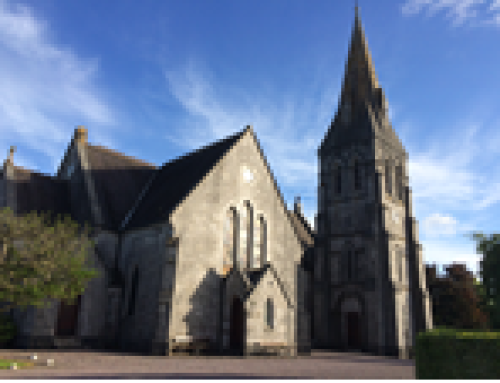Newsletter of Douglas Union with Frankfield August 2019

The Rector writes……
 On the wall in the sanctuary in St Mary’s Church Marmullane, there is a memorial plaque to the Rev. William Meade. It was erected by his son Rev. Richard Meade, who was in charge of the parish at the time. The Rev William Meade died in the vicarage in Passage West on 27 August 1870 aged 72. The plaque states that he had been rector of Inchinabracky. I wondered about this parish and so did some research. I discovered that it is between Midleton and Castlemartyr, near the Two-Mile Inn. The church is a ruin today (see picture). Indeed, it had been so for much of its history and so for many years a house in the area was used on Sundays for worship. However, in 1839 the church was rebuilt and consecrated, and following further research, I discovered that a service was held there every Sunday and Holy Communion celebrated 11 times a year. The Rev. William Meade as rector lived in Midleton as there was no rectory or school in the parish. He received an income of £115, in addition to the one he received as vicar of the nearby parish of Ballyspillane. I wondered about the size of the congregation and so did some further research and discovered the total protestant population of the parish at the time was…12! A church and a rector and a service every Sunday for at most 12 people.
On the wall in the sanctuary in St Mary’s Church Marmullane, there is a memorial plaque to the Rev. William Meade. It was erected by his son Rev. Richard Meade, who was in charge of the parish at the time. The Rev William Meade died in the vicarage in Passage West on 27 August 1870 aged 72. The plaque states that he had been rector of Inchinabracky. I wondered about this parish and so did some research. I discovered that it is between Midleton and Castlemartyr, near the Two-Mile Inn. The church is a ruin today (see picture). Indeed, it had been so for much of its history and so for many years a house in the area was used on Sundays for worship. However, in 1839 the church was rebuilt and consecrated, and following further research, I discovered that a service was held there every Sunday and Holy Communion celebrated 11 times a year. The Rev. William Meade as rector lived in Midleton as there was no rectory or school in the parish. He received an income of £115, in addition to the one he received as vicar of the nearby parish of Ballyspillane. I wondered about the size of the congregation and so did some further research and discovered the total protestant population of the parish at the time was…12! A church and a rector and a service every Sunday for at most 12 people.
Why do I draw your attention to this? Friday 26 July was the 150th anniversary of the passing of the Irish Church Act which disestablished the Church of Ireland. Since reformation times the Church of Ireland was the only officially recognised church and as such it was supported financially by the state and from revenues it received from all the people. This was a tax on all Roman Catholics, Presbyterians, Methodists, Quakers and others, as well as members of the Church of Ireland. It paid the Church of Ireland clergy and generous state funds assisted in building Church of Ireland churches throughout the length and breadth of the country. The official policy was that there should be a Church of Ireland church every 3 miles, so all people had a place of worship belonging to the established church within walking distance. The legacy of this church building policy is still with us today.
The religious inquiry in the Irish Census of 1861 showed that despite all this state support, the established church commanded the allegiance of only one-eighth of the population of the entire island of Ireland. Clearly this situation was untenable. In July 1869 the parliament in Westminster passed an act to change all this. From now on the Church of Ireland would be totally independent the state. Gone were endowments and state subsidies. The church was given a period of time to prepare for this new independence. It came into force on 1 January 1871. The Church of Ireland had only 18 months to reorganise!
Despite the strapline of Disestablishment positively declaring that we were now ‘free to shape our future’, many in the Church of Ireland opposed this development. The acclaimed hymn writer, Mrs Alexander, penned a hymn to mark the occasion that opened with the line: ‘Dimly dawns the new year on a churchless nation’. Rev. William Meade, rector of Inchinabracky and Ballyspillane died before it came into effect. However his son, Rev. Richard Meade was perhaps pessimistic about the future of the Church of Ireland. While he had been in Marmullane since 1867, in 1871 he resigned and moved to England, where he became Vicar of Oatlands in Surrey. However, the family did not completely cut their connections with Cork. Richard’s brother Edward, was appointed Bishop of Cork, Cloyne and Ross in 1893 and remained so until the year of his death in 1912!
If you want to read more about the background and impact of Disestablishment, why not look up the information page on the Church of Ireland website? It can be found on www.ireland.anglican.org.
I end by wishing all parishioners and readers of this newsletter a very restful summer. I hope you will find this prayer I have written helpful.
‘Lord you reminded your disciples of the need for times of rest and refreshment from the stresses and strains of the day. We thank you for every opportunity to travel, to rest and to enjoy new experiences. Watch over our journeys. May our time away be one of warmth and love, so that we return refreshed in body, mind and spirit to continue in your service. Amen.’ Yours in Christ, Adrian.
Zambian Experience: July 2019

Rev. Hazel Minion with Rev Aaron McAllister, Noreen Hurst and Bishop Trevor Williams
After the thunder and lightning in Madrid that completely wrecked our travel itinerary, four weary travellers arrived (luggage-less) in Ndola Airport, Zambia, at 10.50 am on Wednesday 10th July. Keith and Lyn Scott and James, the minibus driver, met us and for the next ten days provided the loving care and guidance that made our stay in Zambia such an amazing experience.
Noreen and I, Rev Aaron and Bishop Trevor had a house on the campus of St John’s Anglican Seminary in Kitwee. The nine final-year ordinands befriended us, joined in lively discussions, prayed with us and helped guide us around some of the six parishes we visited.
Buchi is a lively, forward thinking parish with four choirs, Boys’ and Girls Brigades, Fathers’ Union, Youth meeting… We particularly engaged with the Mothers’ Union who meet weekly. Though they are not wealthy, they bring what they can: vegetables, clothes, etc. These are parcelled and distributed to the widows and needy in the parish.
I’ve spoken in sermons about the lively worship in Kawama Parish where I was welcomed on the Sunday, and invited to preach through an interpreter, a new experience. Joyful singing and dancing and Christian fellowship truly transcended language barriers.
On two days, Archdeacon Richard showed us around the archdeaconry of Chingola, an hour’s drive to the north. In Mutenda Rural Development Centre, a very gifted tutor was leading an in-service course for Early Childhood Development workers. Potential community leaders (some of them older men) had been identified locally. They would visit pregnant mums and mothers of toddlers in the villages with advice and guidance on health, childcare, nutrition and stages of development, keeping alert for any signs of neglect or abuse.
We visited the recently built St Peter’s Church where its priest, Fr Douglas, proudly showed its borehole, dated 29.11.2017. The water is only about 12 ft down, making me think of the potential of this apparently dry landscape.
Another man there explained the traditional naming customs. Grandparents choose the firstborn child’s name. If there are twins, the next child is always called Chola. He has two sets of twins, each followed by a Chola, six children. To send children to primary school they must have a uniform and pay fees of 20 kwacha, about €1.40. Many in that parish do not have the 20 kwacha for fees.
On Thursday we visited Limapela School, run by a New Zealand foundation. 400 pupils, grades 1-8, have a good education under the guidance of a remarkable manager, Michael, and his wife Alison. Fees are higher here as classes are of 30 rather than the possible 80 in state schools, but many of the students are sponsored. The buildings are of a very high quality with a library, computer room and science lab for the older students.
Everywhere prayer and worship are a natural part of people’s lives and underpin all they do. Archbishop Albert Chama very graciously left a family occasion to spend an evening with us, and we gained insights into the life of a very committed and very busy leader. Many of the church problems are very similar to our own. Personally, I was challenged by the faith in God, positive outlook and willingness to have a go of those we met.
Thank you to all who have supported me, followed on Facebook and prayed. Your prayers were indeed worthwhile and answered. As for the money raised by the Book Club and the Confirmees, it is lodged in a CMSI Projects account, awaiting discussion with the person in charge who is currently on holidays, so further details will be in the next issue of Parish Matters. Some morning in September, I plan to share the photographs with any who are interested.
Rev Hazel.




